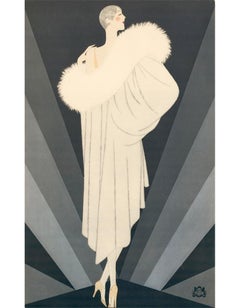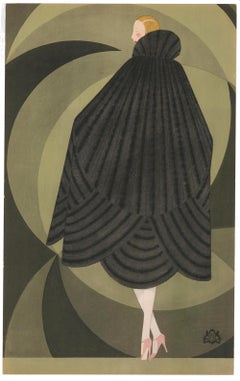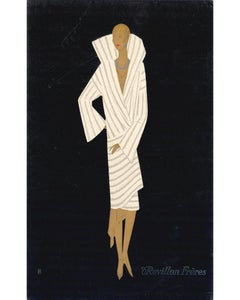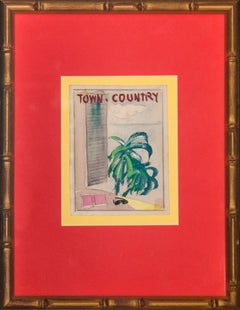Reynaldo Luza Art
to
10
Overall Width
to
Overall Height
to
10
4
4
1
10
7
5
3
3
2
2
2
2
2
2
1
1
1
1
1
1
1
1
6
6
4
2
10
8,779
2,809
1,642
1,313
5
10
Artist: Reynaldo Luza
Revillon Freres: Woman in a Draped Fur Coat
By Reynaldo Luza
Located in New York, NY
Original lithograph, produced as part of a portfolio of images by Reynaldo Luza for the Parisian fur house, Revillon Freres. Paris, Draeger for Revillo...
Category
1920s Reynaldo Luza Art
Materials
Paper
Revillon Freres: Woman in fur cape with starry background
By Reynaldo Luza
Located in New York, NY
Original lithograph, produced as part of a portfolio of images by Reynaldo Luza for the Parisian fur house, Revillon Freres. Paris, Draeger for Revill...
Category
1920s Art Deco Reynaldo Luza Art
Materials
Paper
Revillon Freres: Woman in a Black Fur Cape
By Reynaldo Luza
Located in New York, NY
Original lithograph, produced as part of a portfolio of images by Reynaldo Luza for the Parisian fur house, Revillon Freres. Paris, Draeger for Revillo...
Category
1920s Reynaldo Luza Art
Materials
Paper
Gold Woman Wearing White Fur Coat
By Reynaldo Luza
Located in New York, NY
Luza, Reynaldo.
Trade Catalogue.
This plate: Woman in gold wearing white, striped fur coat with large collar, on black background.
Paris, Draeger for Revi...
Category
1920s Reynaldo Luza Art
Materials
Paper
"Palm Tree Outside Cottage Window" 1950 Watercolor by Reynaldo Luza
By Reynaldo Luza
Located in Bristol, CT
Original illustration commissioned for Town & Country Magazine c1950 by noted Peruvian artist, Reynaldo Luza (1893-1978)
Art Sz: 6"H x 5"W
Frame Sz: 14"H x 11"W
w/ gilt bamboo fra...
Category
1950s Reynaldo Luza Art
Materials
Gouache
Seated Woman in Pink Bathing Suit by Reynaldo Luza (1893-1978)
By Reynaldo Luza
Located in Bristol, CT
Original artwork for Town & Country magazine by Peruvian fashion illustrator, Reynaldo Luza c1950
Art Sz: 6"H x 4 1/4"W
Frame Sz: 14 1/4"H x 11"W
w/ gi...
Category
1950s Reynaldo Luza Art
Materials
Gouache
"Grove of Palms" 1950 Watercolor for Town & Country Magazine
By Reynaldo Luza
Located in Bristol, CT
Original watercolour for Town & Country Magazine c1950 by Peruvian born, fashion illustrator, Reynaldo Luza (1893-1978)
Art Sz: 6"H x 4 1/2"W
Frame Sz: 14"H x 11"W
w/ gilt bamboo...
Category
1950s Reynaldo Luza Art
Materials
Watercolor
Yellow Bikini
By Reynaldo Luza
Located in Bristol, CT
Original c1950s watercolour by Peruvian born/ fashion illustrator, Reynaldo Luza (1893-1978) for Town & Country Magazine depicting a yellow bikini clad '...
Category
1950s Reynaldo Luza Art
Materials
Watercolor
Original Artwork for Town & Country Magazine circa 1950 Chic Sunbather with Blue
By Reynaldo Luza
Located in Bristol, CT
Original watercolour for Town & Country magazine c1950 by Peruvian fashion illustrator, Reynaldo Luza (1893-1978)
Art Sz: 6 1/2"H x 5"W
Frame Sz: 13'H x...
Category
Mid-20th Century Other Art Style Reynaldo Luza Art
Materials
Watercolor
Original Gouache Artwork for Town and Country Magazine by Reynaldo Luza circa 19
By Reynaldo Luza
Located in Bristol, CT
Original gouache artwork for Town & Country magazine circa 1950 by Peruvian fashion illustrator, Reynaldo Luza (1893-1978), pre-eminent fashion artist, wa...
Category
Mid-20th Century Other Art Style Reynaldo Luza Art
Materials
Watercolor
Related Items
Expressionist Figurative water color painting- Series Bath NO.1
Located in Beijing, CN
Artist Biography
Zhang Chunyang was born in 1975 in Changchun, Jilin. She earned her B.F.A at Jilin University of Arts in 1999, and studied at Central Acadamy of Fine Arts, Beijing ...
Category
2010s Expressionist Reynaldo Luza Art
Materials
Watercolor, Gouache, Handmade Paper
$3,040
H 11.42 in W 14.18 in
Kate Moss
By Annie Kevans
Located in New York, NY
Listing includes framing, free shipping to continental US and a 14-day return policy.
Kate Moss by Annie Kevans
20 x 16 inch paper
16 x 20 inch image
Archival pigment print
Edition 15 of 50
Signed and edition on the front of the print
Frame is in fair condition and is included for free due the condition issues. The print itself is in excellent condition. If you would like the print sent unframed the cost is the same. Please let us know if you would prefer to have us ship the print unframed.
Artist Biography -
Kevans’ paintings reflect her interests in power, manipulation and the role of the individual in inherited belief systems. She looks at alternative histories and how they relate to current issues and creates what she describes as ‘anti-portraits’ that may or may not be based on real documentation. She believes that, as her work is concept driven, sometimes the actual similarity to the person depicted in the work is irrelevant. This can be seen in her 'Boys' series which is not about portraying dictators as they really looked as children but rather about the notion of the ‘innocent child’ which has influenced images of children in art...
Category
2010s Contemporary Reynaldo Luza Art
Materials
Canvas, Archival Paper, Archival Pigment
Original Ronald Shap figure drawing, signed
Located in Columbus, OH
Original oil pastel and gouache figure drawing by celebrated, twentieth-century California landscape painter, Ronald Shap. Sketch of a shirtless man in sun...
Category
1990s Contemporary Reynaldo Luza Art
Materials
Oil Pastel, Gouache
“Longchamp”
Located in Southampton, NY
Original colored lithograph of the horse races at Longchamp in Paris, France. The lithographs is done in a classic Art Deco style. Condition is excellent. Circa 1980. Edition size ...
Category
1980s Art Deco Reynaldo Luza Art
Materials
Archival Paper, Lithograph
Louis Gallait (1810-1887) Portrait of a Gentleman, watercolor and gouache
By Louis Gallait
Located in Paris, FR
Louis Gallait (1810-1887)
Portrait of a Gentleman,
Watercolor and gouache on paper, square white lines,
24 x 16 cm
Stamp of the Louis Gallait Estate on the mount on the lower righ...
Category
1850s Romantic Reynaldo Luza Art
Materials
Watercolor, Gouache
Ettore Tito (1859-1941) - On a Souvent Besoin.... Art Deco Pochoir Print
By Ettore Tito
Located in Edinburgh, GB
Art Deco original pochoir print.
Please find the dimensions of the artwork:
20 x 15 cm - Dimensions of the image
26 x 20 cm - Dimensions of the paper
28 x 22,5 cm - Framed dimensi...
Category
Early 20th Century Art Deco Reynaldo Luza Art
Materials
Paper
Faithful Companion, Samode Palace, 2020
By Karen Knorr
Located in New York, NY
Listing includes framing with UV plexi ($1,700 value), free shipping to the continental USA, and a 14-day return policy. Also available for local pick up from our New York gallery.
A Faithful...
Category
2010s Reynaldo Luza Art
Materials
Photographic Paper, Color, Pigment, Archival Pigment
By the Fireside
Located in Paris, Île-de-France
Edouard Bernard DEBAT-PONSAN
(Toulouse 1847 – 1913 Paris)
By the Fireside
Ink, wash, and gouache on paper
15 3/8 x 15 3/4 in
39 x 40 cm
Monogrammed lower right “DP”
Provenance
Private collection, France
This work is a preparatory study related to the artist’s painting Before the Ball...
Category
Late 19th Century Old Masters Reynaldo Luza Art
Materials
Ink, Gouache
Original 70's Hand Painted Textile Design Gouache Green Blue Color on Grey Pape
Located in ALCOY/ALCOI, ES
Flower bouquet design. Sealed on the back with the design studio name and number 484
We offer a small number of these original illustration designs by this design studio based in Al...
Category
1970s Modern Reynaldo Luza Art
Materials
Paper, Gouache
$1,013
H 34.65 in W 18.9 in D 0.12 in
Engraving #1 by Ernst Fuchs: KABBALAH (SEFER YETSIRA and 32 PATHS OF WISDOM)
By Ernst Fuchs
Located in Cliffside Park, NJ
Original engraving #7 by Ernst FUCHS from Kabbalah (THIRTY-TWO PATHS OF WISDOM by SEFER YETZIRA), 1978
Etching signed and numbered 16/30 E.A.
Page size - 30 ...
Category
1970s Modern Reynaldo Luza Art
Materials
Paper, Etching
PEGASUS, Woodcut, Limited Edition, signed by the Artist
Located in Palm Desert, CA
"PEGASUS" (1976) by Norbert Matzdorf
Woodcut print on paper
Limited Edition, numbered (8.3), dated and hand-signed by the artist
27,9 x 38,3 cm
Norbert Matzdorf (1951 – 2013) After ...
Category
1970s Reynaldo Luza Art
Materials
Paper
$200
H 15.08 in W 10.99 in D 0.01 in
Internationale Kunst Ausstellung, Dresden
Located in London, GB
Osmar Schindler, (German 1867-1927), Internationale Kunst Ausstellung, Dresden, 1897 Lithograph, signed (in the plate) (middle right), 96cm x 75cm (100...
Category
1890s Art Nouveau Reynaldo Luza Art
Materials
Paper, Lithograph
Previously Available Items
Revillon Freres: Woman in black fur cape.
By Reynaldo Luza
Located in New York, NY
Original lithograph, printed in color on paper. Produced as part of a portfolio of images by Reynaldo Luza for the Parisian fur house, Revillon Freres...
Category
1920s Art Deco Reynaldo Luza Art
Materials
Paper
Reynaldo Luza art for sale on 1stDibs.
Find a wide variety of authentic Reynaldo Luza art available for sale on 1stDibs. If you’re browsing the collection of art to introduce a pop of color in a neutral corner of your living room or bedroom, you can find work that includes elements of red, pink and other colors. You can also browse by medium to find art by Reynaldo Luza in paint, watercolor, paper and more. Much of the original work by this artist or collective was created during the 20th century and is mostly associated with the Art Deco style. Not every interior allows for large Reynaldo Luza art, so small editions measuring 5 inches across are available. Customers who are interested in this artist might also find the work of Alberto Vargas, Hermine David, and Victor Delfin. Reynaldo Luza art prices can differ depending upon medium, time period and other attributes. On 1stDibs, the price for these items starts at $950 and tops out at $2,500, while the average work can sell for $1,800.








